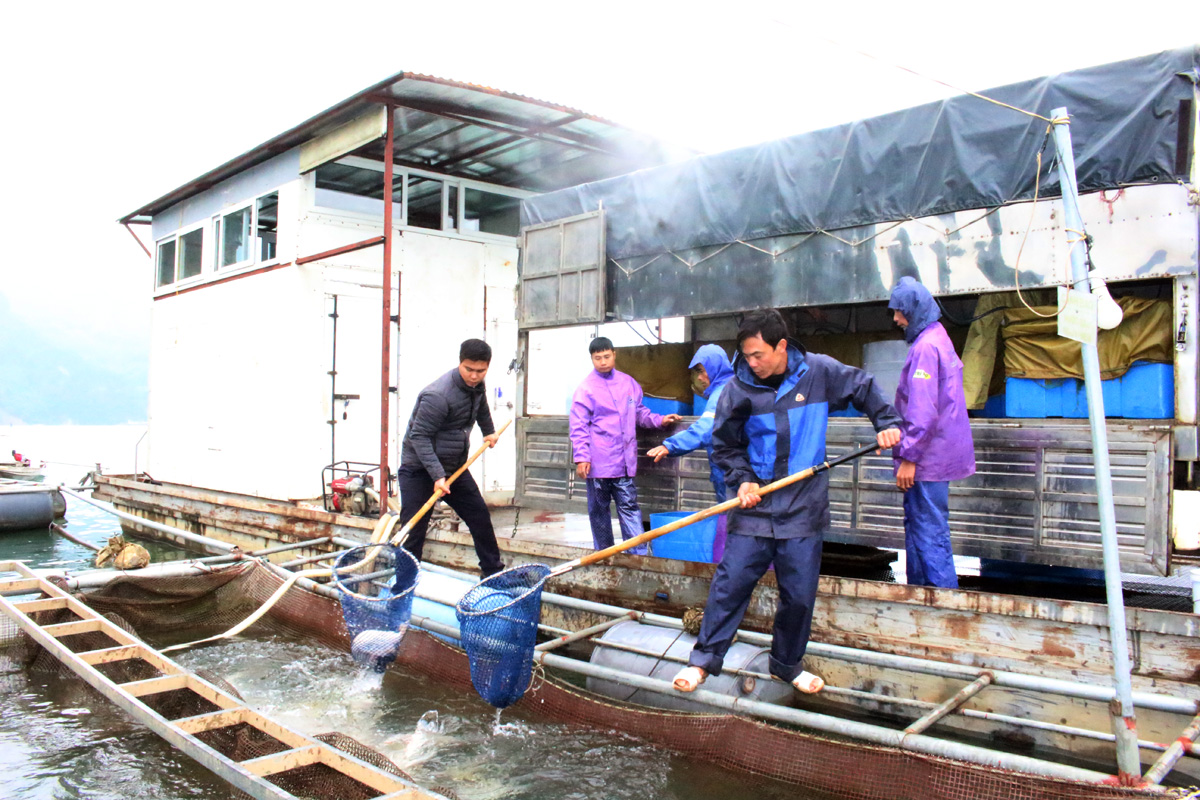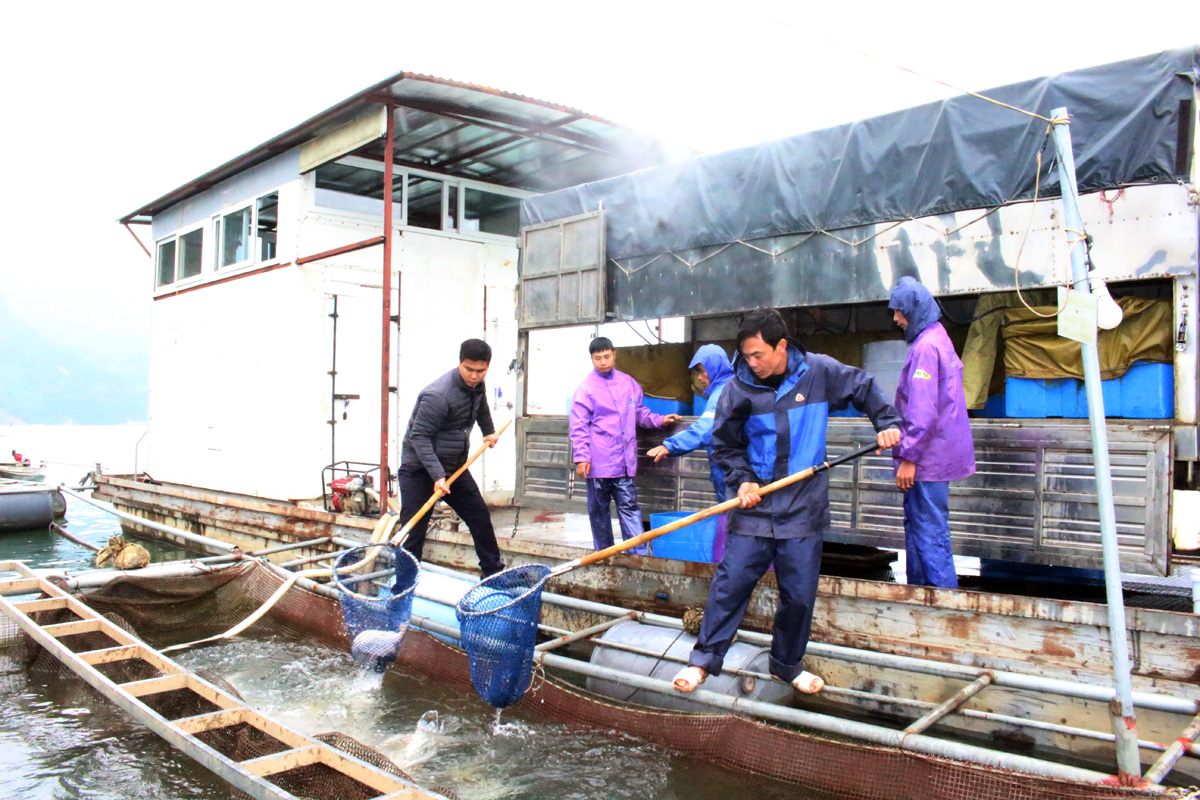
(HBO) – As part of efforts to restructure the fisheries sector towards a higher ratio of cage fish farming and farming on irrigation reservoirs, developing fish raising cages in large rivers and lakes, especially Hoa Binh Lake, with high quality and high-value species using high technology has proved to be a sound policy of the province in boosting fisheries growth.
 The Hai Dang Hoa Binh Seafood Company has invested in cage fish farming in accordance
with VietGAP standards, with products highly welcomed by customers in and
outside the province.
The Hai Dang Hoa Binh Seafood Company has invested in cage fish farming in accordance
with VietGAP standards, with products highly welcomed by customers in and
outside the province.
Hoa
Binh has more than 500 irrigation lakes, especially the Hoa Binh reservoir with
nearly 8,900 hectares of water surface. The reservoir has served electric
generation and farming activities in the Red River delta region, and created
stunning landscape to attract tourists. The reservoir also helps preserve
fisheries resources with more than 90 species. The area is also a hub for large
fish cage farming.
In
order to exploit the province’s water surface, the provincial People’s
Committee has issued policies to support the development of cage fish farming
on Hoa Binh Lake, encouraging businesses to invest in fisheries production. Currently,
the province has 33 fish farms and fisheries cooperatives, with 10 specialised
in aquatic farming and 23 engaging in agricultural in combination with fisheries
production. Some 2.7 million hectares of water surface has been used for
aquaculture, up 510 hectares compared to that in 2015. Many facilities have
expanded their production to more than 100 fish cages. Some businesses have
signed business agreement with fish farmers who meet VietGAP standards in their
fisheries production activities.
The
Hai Dang Hoa Binh seafood company is one of the outstanding and pioneering businesses
in fishing, aquaculture farming and trading of aquatic products. Along with its
farming system with 180 fish cages in Thai Binh ward, the company has expanded
the material region and linked with fish famers in the Da River area with 130
fish cages, with total output of about 500 tonnes per year.
According
to Director of the firm Nguyen Van Toan, major products of the company include black
carps, Hemibagrus nemurus, carps, and Tilapia, which are raised following VietGAP
standards. The company has created jobs for 10 direct and 10 indirect labourers
whose income is 7-9 million VND per month. The company has introduced to the
market fish floss made from fish farmed in the Hoa Binh lake.
The process of
farming of fish and production of fish floss is closely controlled in
accordance with ISO and HACCP standards. In order to bring the product closer
to customers, the company has chosen Hanoi as the first market, with priority
given to safe food shops and supermarkets. Currently, fish floss products
bearing the Da River trademark have been available in 50 shops and supermarkets
in Hanoi and other localities.
In recent years, the policy of restructuring the fisheries sector in Hoa Binh
has helped increase aquaculture output, especially cage farming output.
By the end of 2020, the locality had 4,700 fish farming cages on rivers and
lakes, an increase of 3,400 cages. The output reached 11,000 tonnes, doubling from
the output in 2015.
The model of cage-fish
farming has been developed mainly in large water bodies in combination with irrigation
exploitation.
To regenerate aquatic resources and increase exploitation output, every year,
the local agricultural sector paid attention to building plans on protecting
aquatic resources, releasing fingerlings into natural water bodies.
Activities to
protect aquatic resources, and the fisheries co-management model in Hoa Binh
lake basin have been implemented effectively, helping sustainably exploit natural
aquatic resources.
Localities across the province have strongly promoted aquaculture development on
the basis of tapping their potential and comparative advantages, using intensive
and semi-intensive farming, and advanced extensive farming techniques.
In
order to create sustainable development, the provincial Department of
Agriculture and Rural Development has directed the development of models of
joint venture and association in production, preservation, processing and
consumption.
Accordingly, a chain linkage model has been built from fingerling production,
farming, and consumption.
To ensure safe cultivation of aquatic products and create sustainable market for
local aquatic products, the province has implemented a fish farming chain in Da
River since 2016.
In 2017, a project to link production and consumption of Da river fish specialty
in a value chain in Da Bac district and Hoa Binh city was implemented.
The Da River trademark for fish and shrimp produced in Hoa Binh has been
recognised by the National Office of Intellectual Propertyof Vietnam, creating favourable condition for
the locality to expand production and consumption markets, towards
improving the quality of products for export. /.
Mai Chau district has firmly established itself as a standout destination on Vietnam’s tourism map, attracting both domestic and international visitors with its breathtaking landscapes, rich ethnic culture, and warm hospitality. However, beyond its natural and cultural charm, a secure and well-managed tourism environment has added to Mai Chau’s appeal.
As Vietnam enters a new phase of economic and administrative reform in 2025, Hoa Binh province is stepping up its efforts to streamline governance, boost economic growth, and attract investment.
The Hoa Binh provincial People's Committee held its monthly meeting on March 26 to review the progress of key projects, assess budget revenue and public investment disbursement, provide feedback on draft documents for submission to the provincial Party Committee's Standing Board, and discuss other important matters related to the committee's governance activities.
Playing a key role in Hoa Binh province’s economic development, Luong Son district has been focusing on science and technology development, innovation, and digital transformation.
Identifying the application of online public services as a key step in administrative procedure reform and e-government building, Kim Boi district has proactively provided services and supported residents and businesses in accessing and utilising full-process online public services promptly and efficiently. The locality aims to lift the rate of end-to-end online public services to over 90%, with all officials and civil servants handling tasks in the digital environment.
Nguyen Anh Tuyet, hailing from a family steeped in the ancient art of herbal medicine, is transforming local medicinal herbs into high-value concentrated extracts, elevating their worth and healing potential.



 The Hai Dang Hoa Binh Seafood Company has invested in cage fish farming in accordance
with VietGAP standards, with products highly welcomed by customers in and
outside the province.
The Hai Dang Hoa Binh Seafood Company has invested in cage fish farming in accordance
with VietGAP standards, with products highly welcomed by customers in and
outside the province.